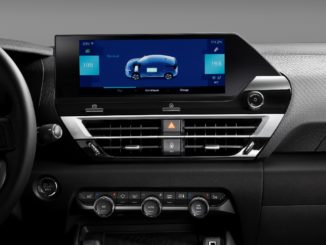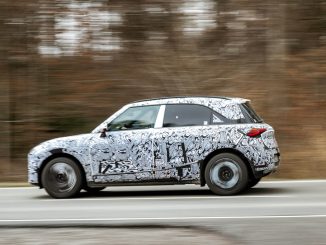
Renault Filante Record 2025 is an electric demo car developed to maximise energy efficiency and set a new record for power consumption and range.
The car is powered by 87 kWh battery, the same capacity as on Scenic E-Tech electric.
A single-seater with a streamlined body design for aerodynamic efficiency, Renault Filante Record 2025 is a car of exceptional dimensions: 5.12 metres long and 1.19 metres tall and weighing just 1,000 kg.
A laboratory on wheels for testing new technologies, materials and innovations, Renault Filante Record 2025 is fitted with unique friction-reducing tyres, along with steer-by-wire and brake-by-wire technologies.
It will be on show at the Rétromobile motor show in Paris from 5 to 9 February 2025, before setting out to establish a new record for efficiency in the first half of the year.
Renault Filante Record 2025 is no ordinary concept car. It is an electric demo car, designed to be bold and innovative, fusing Renault’s rich heritage with a futuristic vision of electric mobility.
Inspired by the legendary 40 CV des Records (1925-1926), Nervasport des Records (1934) and Etoile Filante (1956), this single-seater appears to be sculpted by air. It is not only an exercise in style, but also a demonstration of exceptional aerodynamic efficiency and cutting-edge technology, underlining Renault’s commitment to innovation and more sustainable and efficient mobility.
The designers set out to create a monolithic sculpture of clean, flowing lines that could almost be described as organic.
We designed this vehicle as a sculpture in motion. Inspired by fighter planes and the speed records of the nineteenth century, it reflects both performance and timeless elegance. Every inch of the surface was crafted to capture the light and showcase the body lines, which appear to melt into the air. The blue windows and colour palette further underline this light and airy impression. The design as a whole seeks to convey an impression of flow and lightness – said Sandeep Bhambra, Director of Advanced Design, Renault and Ampere.
Historical influences revisited
 Renault Filante Record 2025 features bodywork in Ultraviolet Blue, a new shade that looks blue or violet depending on the reflections of the light and the viewing angle. Reminiscent of the 40 CV des Records, this colour was recreated specially for Filante Record 2025. Many other details also bring to mind the iconic models that inspired the design of the demo car: the round headlamps, the wheels separated from the body (40 CV des Records and Nervasport des Records), and also the wheel fairings (Etoile Filante), pointed grille, cabin position and seat adjustment strap (40 CV des Records). All these shapes and parts remind us of the past while fusing perfectly with the contemporary look of Renault Filante Record 2025. Integrating smoothly and harmoniously with the vehicle’s futuristic vision, they create a natural dialogue between past and future.
Renault Filante Record 2025 features bodywork in Ultraviolet Blue, a new shade that looks blue or violet depending on the reflections of the light and the viewing angle. Reminiscent of the 40 CV des Records, this colour was recreated specially for Filante Record 2025. Many other details also bring to mind the iconic models that inspired the design of the demo car: the round headlamps, the wheels separated from the body (40 CV des Records and Nervasport des Records), and also the wheel fairings (Etoile Filante), pointed grille, cabin position and seat adjustment strap (40 CV des Records). All these shapes and parts remind us of the past while fusing perfectly with the contemporary look of Renault Filante Record 2025. Integrating smoothly and harmoniously with the vehicle’s futuristic vision, they create a natural dialogue between past and future.
However, it is the world of aeronautics that provides the main inspiration for the design of this demo car. With its protective aerodynamic bubble, the cabin brings to mind a fighter jet. At the same time, every detail of the bodywork has been optimised to reduce drag, with features that bring to mind the curves and shapes of high-performance aircraft.
The front and rear wheel fairings are another eye-catching detail, contributing to the style of the vehicle while playing a fundamental role in its aerodynamic performance. The fairings reinforce the monolithic appearance of the vehicle while improving air penetration. Along with the wide side wheel flanges, they contribute to the uninterrupted flow of the body and the absence of visible breaks.
In pursuit of efficiency and performance
Weight was also a priority in the design of Renault Filante Record 2025. The visible screws on the bodywork are inspired by aircraft construction techniques. The purpose is not only to make the car lighter but also to give it a contemporary, high-tech look. Alongside the other design features inspired by the world of aeronautics, these visible screws underline the brand’s commitment to innovative and more sustainable vehicle design.
The design of this demo car is about much more than looks: it is part of an approach to push the limits of efficiency and performance. From the aerodynamic fairings to the lightweight chassis, every feature was designed to maximise energy efficiency. At the same time, the historic and aeronautical inspiration give this vehicle a unique personality, with its sights set squarely on the future.
A cockpit that was also designed for performance
 The interior design of Filante Record 2025 takes the same approach as the exterior, with a cockpit inspired by the worlds of aviation and space travel, in which every detail is designed to maximise performance, comfort and efficiency. In this pared-down environment, each component or system (safety and opening functions, cruise control, accelerator, braking, etc.) is within easy reach of the driver, with a design geared towards ergonomics and weight reduction. The choice of materials also reflects this thinking. The driver’s seat, for example, is made from stretched canvas, similar in style to a hammock, for a lightweight design with optimum support.
The interior design of Filante Record 2025 takes the same approach as the exterior, with a cockpit inspired by the worlds of aviation and space travel, in which every detail is designed to maximise performance, comfort and efficiency. In this pared-down environment, each component or system (safety and opening functions, cruise control, accelerator, braking, etc.) is within easy reach of the driver, with a design geared towards ergonomics and weight reduction. The choice of materials also reflects this thinking. The driver’s seat, for example, is made from stretched canvas, similar in style to a hammock, for a lightweight design with optimum support.
The seat adapts to the body shape of the driver, who feels as one with the vehicle. The seat is supported by thin carbon blades clad in a technical textile, a choice again inspired by the aeronautics and aerospace industries, where every gram is important in maximising performance.
The integration of the controls and instruments reflects a flowing, minimalist approach. Each function is displayed on an ultra-thin digital screen.
The steering wheel is the visible component of an innovative control architecture: its handles control the acceleration, braking and steering functions using fully electronic steer-by-wire and brake-by-wire technologies, discreetly integrated into a 3D printed structure made of Scalmolloy. This approach is inspired by aeronautical technologies, where controls need to be both ergonomic and rapidly accessible. At the centre of the steering wheel, a flexible panoramic screen wrapped around a cylinder provides a clear and immediate display of essential data, such as speed, range and driving parameters. Finally, the steering wheel is attached to the protective bubble of the cockpit, rising upwards when it is opened to make it easier for the driver to get in and out.
An ingenious system of air circulation makes it possible to ventilate the cockpit without the need for more technical parts, again with a view to weight and energy savings.
The F1-inspired driving position is designed for ergonomics and visibility. The driver’s legs are positioned over the batteries, for a better architectural result.
Aerodynamics and weight control, the keys to energy efficiency
 Based on a collaboration between engineering and design teams from Renault and Ligier Automotive, the Filante Record 2025 demo car features an exceptional ultra-aerodynamic design, optimised for performance.
Based on a collaboration between engineering and design teams from Renault and Ligier Automotive, the Filante Record 2025 demo car features an exceptional ultra-aerodynamic design, optimised for performance.
The ambitious goal of this project demanded a close focus on styling to achieve the highest level of aerodynamic performance.
To this end, the aerodynamics engineers sought to optimise the airflow around the car, with particular emphasis on the transition between the different parts of the vehicle. The elongated shape of the single-seater played a key role here, since longer vehicles allow better control of the aerodynamic flow, thereby reducing interference.
The wheels are normally major sources of aerodynamic interference, but they have been carefully faired here in order to minimise their impact on performance. At the same time, the suspension arms were also faired-in, with design lines that reflect aerodynamic logic.
Simulation and validation in wind tunnels
The project involved close collaboration between the design and aerodynamics teams, in order to strike a balance between performance and looks. While some choices required a compromise, it was considered a priority to comply with styling intent while ensuring exceptional aerodynamic performance.
While the aerodynamic development process has been guided to date by cutting-edge numerical simulations, engineers plan to carry out wind tunnel tests in spring 2025. These tests will serve to confirm simulation results and to make any adjustments necessary to perfect vehicle design for optimal aerodynamic performance.
Watch the video
Source: Renault


















Be the first to comment